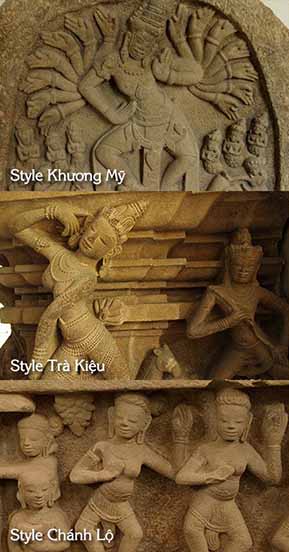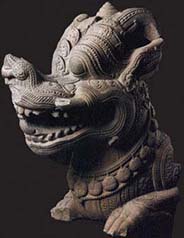Vietnamese version

Mỹ Sơn A 1 Style
Phong Cách Mỹ Sơn A 1 (Xth century)
French researcher Jean Boisselier distinguishes two styles. The first style is known under the name of Khương Mỹ (first half of the Xth century) and it is constituted by the works adopting again some features found in the Ðồng Dương style. As to the second style, it is called under the Trà Kiệu name (second half of the Xth century) and it brings together the works getting completely off the Đồng Dương style. We note a increasingly marked indo-Javanese influence after having taken Khmer influences.
In the Khương Mỹ style, we observe in both harmony and symmetry. The sweetness is also visible in the facial expressions to the sculptures. Regarding the Trà Kiệu style, in addition to the sweetness found in poses and faces, we find the beauty of the adornments, the half-smile, the trend toward the high prominent reliefs etc. ..The development of female beauty is no longer in doubt (breasts fully developed, broad hips, the elegance of the body etc ..) in the Cham sculpture during this period.
Phong Cách Mỹ Sơn A 1
In the Trà Kiệu style’s prolongation, there’s the Chánh Lộ style (11th century) where we are a witness to the return of main features: thick lips, wide mouth, arch of eyebrow in relief. In this style, there is the absence of the half-smile on the face, the disappearance of the broad hips, the simplification of ornament and cap ( Kirita-Mukuta ). We can say that it is in fact a return to the past. This style is only a transition style between those of Mỹ Sơn A 1 and Bình Ðịnh.
Tháp Mắm style
(or Bình Ðịnh style)
The latter stretches with its extensions, from 11th century until the end of the 13th century. The Champa became a Khmer province for twenty years (between 1203 and 1220). It is for this reason that the significant influence of the Angkorian art is found in this style. It is not by chance that French researcher Jean Boisselier imputes the beginning of the 13th century of Tháp Mắm style to the Bayon style in the Cham art.
The Tháp Mắm style is both eccentric by the enrichment of the decor and the expression of fantastic animals, deities and dvarapalas (thick lips, pupils not marked, eyebrows in clear relief, nostrils dilated, a beard, mustaches)
Phong Cách Tháp Mắm
The works of this long period show close relationships, not only with Khmer art but also with Vietnamese art. The dragons of Tháp Mắm, towers of gold, silver and ivory, demonstrate the Vietnamese influence (period of Lý and Trần dynasties). In this style, the animal sculptures are very varied but they reflect the unrealistic and mythical character. Sometimes, some ferocious and nasty animals very pushed to implausibility and exaggeration, become charming and cute creatures.
Makara
One can have the same ambiguous idea of French researcher Jean Boisselier on the Champa art by asking oneself if one encounters a decadent work or one is at the top of a art pushed to its limits. Vietnamese researcher Ngô văn Doanh has the opportunity to compare this style to the ray of light before the nightfall. Although this one is splendid and blazing hot, it is too « old« . It is about to disappear with regrets for giving way to Yang Mun and Pô Rome styles.
Tháp mắm style
Phong Cách Muộn
Yang Mum et Pô Rome styles
( XIVth -XVth century)
One finds in these styles the mediocre and schematic character. There is a tendency to stylize your carved images and to neglect the rest, in particular the lower limbs that are sometimes reduced to a triangular stone block or a pedestal. The kut (or funerary steles the base uncarved is buried under the growth) show with rudeness a human silhouette without anyone knowing there is a Muslim influence or a return to the animist past.
Hinduism gives way to new forms of religion (cult of local geniuses (the Yang), animism, islam) since the fall of Vijaya (Bình Ðịnh) in 1471 against the Vietnamese (Lê Thánh Tôn) and the loss of all holy places (Mỹ Sơn, Trà Kiệu, Đồng Dương), which thus express a long and irreversible twilight for Cham sculpture. Being left in oblivion since so many years and recently appropriated by the Vietnamese, the Champa sculpture goes back to be their object of admiration since the exposure of Vietnam art treasures (2005 Guimet Museum, Paris) and one of the major components of Vietnamese art. Now, it is an integral part of the artistic and cultural heritage of Vietnam.
- La statuaire du Champa. Jean Boisselier. Volume LIV, EFEO Paris 1963.
- Văn hóa cổ Champa. Ngô Văn Doanh . NXB Dân Tộc 2002
- Champa sculpture. Nguyễn Thế Thục. NXB Thông Tấn 2007
- Jean Boisselier . La statuaire du Champa. Recherche sur les cultes et l’iconographie.
- Bénisti Mireille: Arts asiatiques. Année 1965. Volume 12. N°1.
- L’art du Champa. Jean François Hubert. Editeur Parkstone Press International. 2005
- Pérégrinations culturelles au Champa. Nguyễn Vă Kự, Ngô Văn Doanh, Andrew Hardy. Editions Thế Giới Publishers 2005







